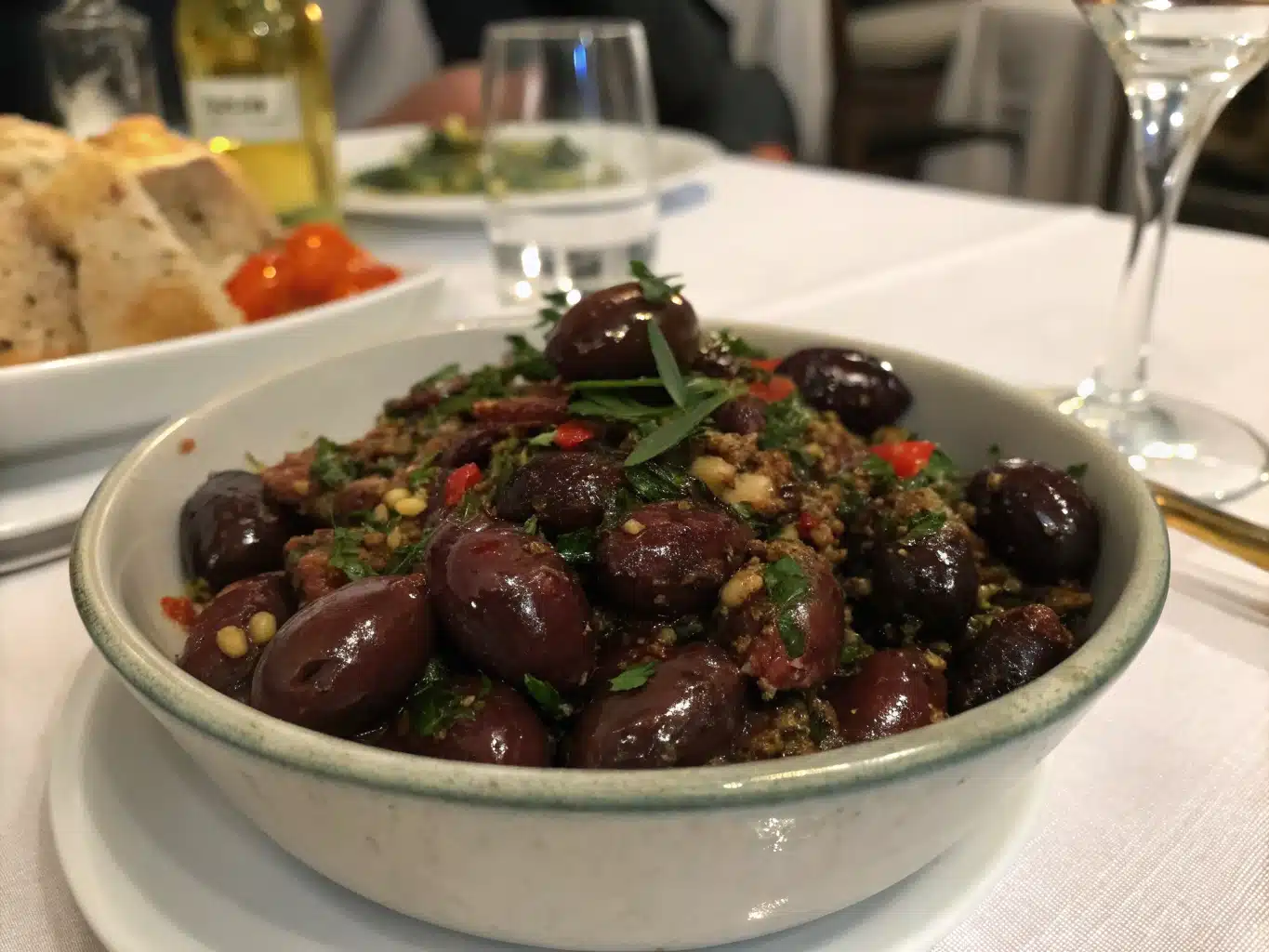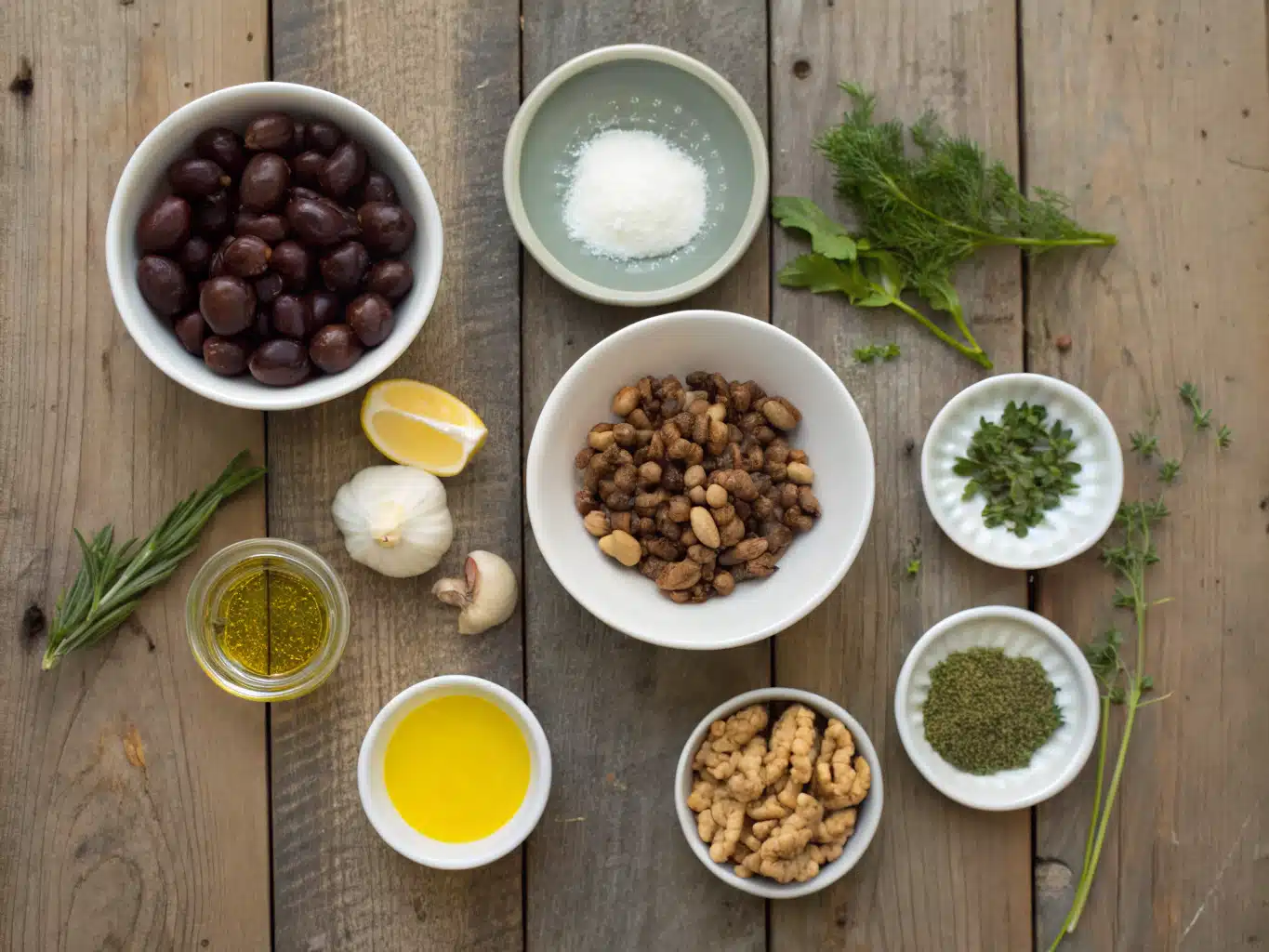
Table of Contents
Few ingredients light up my kitchen the way kalamata olives do. As a plant-based chef living in Portland, my pantry is stocked with robust flavors, and kalamata olive tapenade earns its spot permanently. The first time I made tapenade, I was trying to impress a friend with a Mediterranean-inspired picnic platter. I didn’t expect something so simple—just olives, garlic, and a few pantry staples—to blow us both away.
That day changed how I thought about appetizers. Kalamata olive tapenade wasn’t just a flavor booster—it became the star. Since then, it’s been my go-to for good nights, quick-lunch crostini, and even sandwich spreads. The salty richness and tangy bite give effortless elegance to any dish. In this article, I’ll take you through its story, ingredients, preparation, and irresistible uses. Whether you’re new to tapenade or looking to elevate your culinary game, you’ll find everything you need to master this incredibly versatile recipe.
The Heart of the Mediterranean: Kalamata Olive Tapenade
A Timeless Spread with Rustic Roots
If you’ve traveled the south of France or wandered through a Greek coastal market, you’ve likely tasted a variation of tapenade. The version rooted in Provençal cuisine typically combines olives with capers and anchovies. But the Mediterranean’s influence stretches wide, and Greek kalamata olives bring a different depth—smooth, meaty, and unmistakably bold flavor.
What I love about kalamata olive tapenade is how it takes me back to those backyard moments, slicing heirloom tomatoes while a bowl of tapenade chilled nearby. When blended just right, it holds flavor in each bite that’s equal parts salty, tangy, and earthy. It’s a recipe that honors tradition while lending itself to reinvention.
Even better, it’s delightfully fuss-free. Compared to dips that require morning prep or tools galore, tapenade happens in minutes—just toss and blend. Whether you’re welcoming guests or just want something bold on toast, kalamata olive tapenade is always up for the task.
Why Kalamata Olives Steal the Show
Kalamata olives, native to the southern Peloponnese of Greece, are more than just an ingredient—they’re a statement. With their dark purple hue and almond shape, these olives are picked ripe and brined with care, creating a depth that shines in spreads, salads, and even pasta.
When choosing olives for tapenade, avoid those canned generic varieties. Kalamatas bring the right balance of brine and body. They also contain antioxidants like oleuropein and are rich in heart-healthy fats. In fact, according to the USDA, olives—especially dark varietals—deliver more phenolic compounds than many fruits and vegetables combined. That’s a reason to snack guilt-free.
For those looking to expand their olive-based palate, don’t miss the creamy kalamata olive hummus or even a bold kalamata olive dip that’s equally delightful with crackers or veggie sticks.
Tapenade Recipe Guide: Flavor in Every Scoop
Ingredients List

Your tapenade’s quality depends on the vibrancy and texture of its ingredients. Here’s what you’ll need to capture the best flavor:
| Ingredient | Substitution/Note |
|---|---|
| 1 cup pitted kalamata olives | Use a mix of green and kalamata for lighter flavor |
| 2 tablespoons capers | Optional, but adds sharpness |
| 2 cloves garlic | Roast for milder flavor |
| 1 tablespoon fresh lemon juice | Add zest for extra citrus burst |
| 3 tablespoons extra virgin olive oil | Good quality oil makes a difference |
| Fresh thyme or oregano (optional) | Herbs elevate aroma |
Timing and Quick Prep Breakdown
There’s beauty in simplicity. This recipe takes under 10 minutes from start to serve, making it faster than most dips requiring refrigeration or baking.
- Prep time: 5 minutes
- Cook time: 0 minutes
- Total time: 5–7 minutes
That’s roughly 30% quicker than most hummus recipes and without the soaking or boiling. It’s ideal for last-minute entertaining or elevating weeknight meals. Just like the delightful kalamata olive salad, it’s all about flavor in minimal time.
Step-by-Step Instructions to Make Kalamata Olive Tapenade
- Add the kalamata olives, capers, and garlic to a food processor. Pulse 5–6 times until everything is evenly chopped but not pureed—chunky texture works best.
- Pour in lemon juice and olive oil while pulsing again. Let it blend just until the mixture holds together but is not completely smooth.
- If you’re feeling bold, toss in some fresh herbs or a twist of lemon zest for extra complexity.
- Taste and adjust. Want it tangier? More lemon. A brinier bite? A few extra capers.
- Scoop into a bowl and serve with crusty bread, crackers, or veggie sticks.
As a bonus tip: Let it sit for 15 minutes at room temperature before serving. The flavors marry beautifully, giving richer impact per bite.
How to Make Tapenade Your Kitchen MVP
Perfect Pairings for Kalamata Tapenade
Tapenade is the unsung hero of fast, flavorful food. It transforms dishes from basic to memorable. I’ve spooned it over grilled tofu, folded it into sandwiches, and even stirred it into warm pasta.
Some favorites? Try it with recipes featuring kalamata olives and feta or slathered on sourdough next to a side of kalamata olive bread. Add it to your next charcuterie board and watch it vanish.
For pasta night, mix it with olive oil and toss it into penne or spaghetti. One of my clients loved it so much we created a full kalamata olive tapenade pasta spin-off recipe.
Want new ways to serve it? Here are more pairings:
| Dish Name | Why It Works |
|---|---|
| Veggie wrap with hummus | Adds salty contrast and creamy texture |
| Chickpea flatbread | Pairs well with savory and soft bases |
| Stuffed mushrooms | Elevates earthiness with tangy zest |
Health Benefits That Pack a Punch
Surprisingly, this bold spread isn’t just delicious—it supports your heart and immune system. Kalamata olives are a rich source of monounsaturated fats, and olive oil amplifies those benefits further. According to the National Library of Medicine, compounds in olives may reduce inflammation and oxidative stress.
By skipping anchovies in this plant-based version, you avoid cholesterol while preserving full-bodied flavor. Add in garlic’s antimicrobial properties and lemon’s vitamin C, and you’ve got a small dish with a big nutritional impact.
So the next time you’re spreading kalamata tapenade on toast, know you’re doing your body just as many favors as your taste buds.
Storing and Adjusting Your Tapenade
How to Store Without Losing Flavor
Homemade kalamata olive tapenade stores incredibly well—up to 10 days in an airtight container in the fridge. To keep it tasting fresh longer, always top it with a thin layer of olive oil to prevent oxidation.
Pro tip: It also freezes beautifully. Spoon tablespoons into silicone trays. Pop out and thaw just what you need. That way, it’s always on hand, even for surprise guests or rushed dinners.
Like our robust chicken with kalamata olives, the tapenade intensifies over time—so a second-day spread often hits harder!
Adapting Tapenade to Fit Your Preferences
The best thing about tapenade? It’s endlessly customizable.
Want a smoky flavor? Add sun-dried tomatoes or roasted red peppers. Craving a bit of heat? Toss in chili flakes or a bit of jalapeño. Looking for creaminess? A handful of walnuts or a tablespoon of tahini does wonders.
You could even mix it with vegan cheese for a quick, flavorful topping or use it in sandwiches like a tapenade aioli blend. Explore combinations, and don’t be afraid to make it your own.
FAQ
What is olive tapenade?
Olive tapenade is a savory spread traditionally made from finely chopped or blended olives, capers, and olive oil. It often includes garlic, lemon juice, and optional herbs or anchovies. This plant-based version uses kalamata olives for rich, distinct flavor without animal products.
How do you make Kalamata tapenade?
Start with pitted kalamata olives, capers, garlic, lemon juice, and olive oil. Blend them in a food processor until you achieve a slightly chunky texture. Add herbs or lemon zest if desired, and store covered in the fridge.
How long does homemade tapenade keep?
Stored in an airtight container and topped with a thin layer of olive oil, it keeps in the refrigerator for up to 10 days. For longer storage, freezing in small portions is ideal.
What dishes pair with tapenade?
Tapenade pairs beautifully with crusty bread, roasted vegetables, flatbreads, or sandwiches. You can also mix it into pasta, stuff it into mushrooms, or use it as a dip for veggies.
Conclusion
Kalamata olive tapenade is more than a spread—it’s a flavorful tribute to Mediterranean simplicity and boldness. With its quick prep, rich profile, and nutritional perks, it’s bound to become a favorite in your kitchen. Whether on toast, in wraps, or alongside kalamata olive-inspired pasta, this tapenade consistently impresses and elevates. Give it a try, share it with friends, and don’t be surprised when they ask for your secret. It’s just olives—but oh, what olives they are.
Print
Kalamata Olive Tapenade: A Bold, Flavor-Packed Taste of the Mediterranean
- Total Time: 5–7 minutes
- Yield: 1 cup 1x
- Diet: Vegan
Description
A bold, plant-based Mediterranean spread made with kalamata olives, capers, garlic, lemon juice, and olive oil. Quick, versatile, and packed with flavor.
Ingredients
1 cup pitted kalamata olives
2 tablespoons capers (optional)
2 cloves garlic
1 tablespoon fresh lemon juice
3 tablespoons extra virgin olive oil
Fresh thyme or oregano (optional)
Instructions
1. Add the kalamata olives, capers, and garlic to a food processor. Pulse 5–6 times until everything is evenly chopped but not pureed.
2. Pour in lemon juice and olive oil while pulsing again. Blend until the mixture holds together but remains slightly chunky.
3. Add fresh herbs or lemon zest if desired for complexity.
4. Taste and adjust. Add more lemon juice or capers to balance flavors.
5. Scoop into a bowl and serve with bread, crackers, or veggie sticks.
6. Let sit for 15 minutes at room temperature before serving to enhance flavor.
Notes
Can be stored in the fridge up to 10 days with a layer of olive oil on top.
Freezes well in small portions.
Easily customized with sun-dried tomatoes, chili flakes, or nuts for variation.
- Prep Time: 5 minutes
- Cook Time: 0 minutes
- Category: Appetizer
- Method: Blending
- Cuisine: Mediterranean
Nutrition
- Serving Size: 2 tablespoons
- Calories: 90
- Sugar: 0g
- Sodium: 420mg
- Fat: 9g
- Saturated Fat: 1.5g
- Unsaturated Fat: 7g
- Trans Fat: 0g
- Carbohydrates: 1g
- Fiber: 0.5g
- Protein: 0.5g
- Cholesterol: 0mg
Keywords: kalamata olives, vegan spread, appetizer, Mediterranean, olive dip, plant-based
